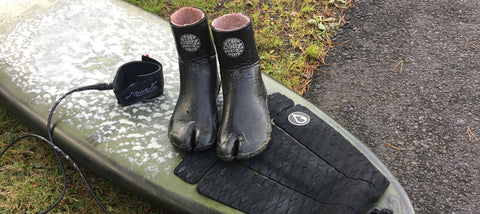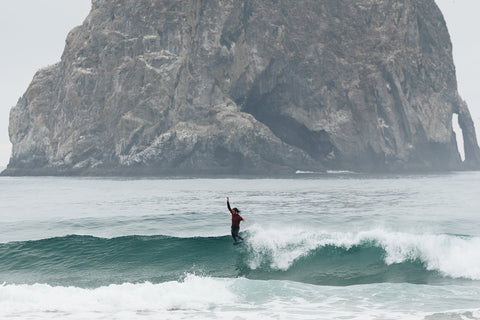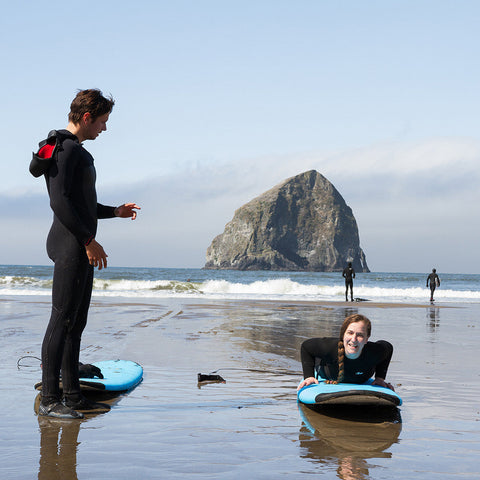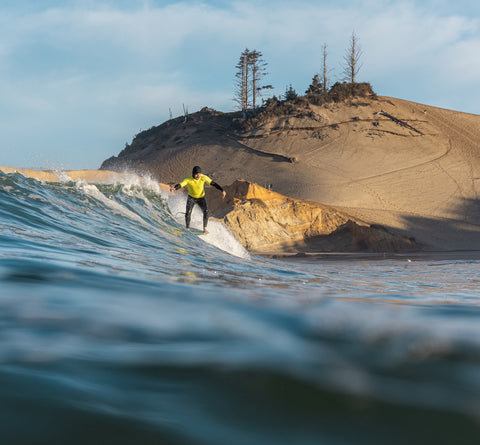Let me start off by saying I’m not a real fan of boots. Well, at least I wasn’t. I used to hate how they made you feel like you were surfing with skate shoes on, blindly bumbling around with no feel for your board at all. It’s bad enough we have to wear ridiculously thick wetsuits to stay warm all year long. Add on a set of big, clunky boots and you’ve got the icing on the cake for completing the circle of immobility and general feeling of being related to the stay puff marshmallow man.
Luckily, I’ve found a solution around that, and I’ve turned a corner on my feeling about boots. I like them now; no I even prefer them (to an extent!). My switch to wearing the Rip Curl Rubber Soul Boots has single handedly cured me of my bootphobia. Now to be fair, I have not tried any of the other companies dipped boots (O’Neill, Xcel, Quiksilver and others all make dipped boots, and I assume that this review could be similar for all of these), but this is mainly because I tried the Rip Curl’s first, and I see no reason to stray away from what works.
It didn’t happen overnight however, and after one session, I was not a believer of these funny sock-looking booties. My first attempt wearing them actually left me thinking I preferred my old boots. I promptly put my rubber souls on the back burner for about three months. Then my trusty old pair of normalized boots (you know, the standard style with straps across the top of your foot that you synch down to oblivion) basically tore in half, and I was forced into giving them another shot.
Moment Web Designer Mattie Starr testing his Rip Curl Rubber Soul Plus boots in some serious surf.
The pair I had was the 5mm Rubber Soul Plus model, with a plush Flash Bomb lining on the inside and smooth slick skin everywhere else. I found them to be kind of a pain in the ass to get on, as I felt like I was going to rip them when I pulled them on. I also couldn’t get my head around not having a strap across the top of my foot to synch the boot down tight. I kept getting a weird feeling that my boot was going to get sucked off on a solid duck dive.
On the positive side, these things were warm. I mean really WARM. My feet felt like they were sitting by a fire my entire session, and never once leaked. After a few surfs, the feeling that my boots were going to get sucked off started to fade, and I started to truly appreciate how flexible these boots were. By removing the straps and having the boots all one solid material, it allows your foot to flex much more naturally, as if you were wearing a high end sock rather than a shoe.
Mattie putting the Rubber Soul Plus boots to the test
After pinpointing the flexibility factor, I took it one step further and made some customizations of my own, and found the formula I still use today. I felt like although these boots were far more flexible and natural feeling than your standard pair of boots, they still needed that extra spice. One day, after they were fully broken in, I decided to take a chance, and cut the little rubber piece connecting your big toe to the rest of the boot. I carefully cut out the rubber with some sharp scissors, taking the time to make sure I didn’t accidently stab the boot in the process and make a hole. This made all the difference to me. It freed up my toes, and is the closest feeling I’ve come to being barefoot while wearing boots.
People always ask me how durable these things are and I think that is a fair question. The boots in question became available about 3 years ago, and I jumped on the train about 6 months from their release. I have gone through several pairs during that time, but I also surf A LOT. For reference, I used to go through a certain pair of extremely popular boots every two to three months, and not because I was being picky, but because they would be in pieces. I actually feel that the Rubber Soul Plus Boots are more durable than a standard boot as far as normal wear goes. Because they are all slick skin, they don’t blow out as easily as a normal nylon neoprene boot. That being said, these boots are prone to tearing by fingernails if not careful when putting them on or taking them off, and they could be more susceptible to tears if you frequent a rocky spot. The main trick for getting them on easily is to make sure they are wet. When they get dry, they are a total pain in the ass to get on. However your average wear and tear such as walking down long trails on gravel or pavement seems to give these no problems.
Overall, I would highly suggest that you give a pair of these or an equivalent dipped boot a shot the next time you need some boots.
Pros:
- Warm (Can even get away with 3mm if your feet don’t normally get too cold)
- Flexible – Feels more natural, can feel the board better
- Durable (normal wear)
Cons:
- Hard to get on
- Durability questions (when surfing rocky spots)
Overall:
Best boots I’ve tried, give them a shot!















